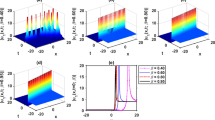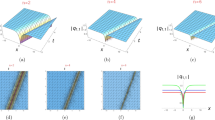Abstract
The purpose of this present paper is to find the Lie-series solutions of the photo-gravitational restricted three-body problem and to apply this Lie-series theory in binary stellar systems. In this paper, we have taken four stellar binary systems namely Kepler-34, Kepler-35, Kepler-413 and Kepler-16. Firstly, the zero-velocity curves are studied in the four binary stellar systems. The Lie-integration method is a concept to deal with the system of ordinary differential equations(ODEs) with the help of Lie-series. We have applied this method to solve the equations of motion of restricted three-body problem with radiating primaries and obtained the solutions of the equations of motion. Then the solution obtained by Lie-series method is compared with that of obtained from the well known Runge-Kutta method. In addition, we have shown the absolute errors graphically for Lie-series method and Runge-Kutta method.








Similar content being viewed by others
References
Abouelmagd, E.I., Guirao, J.L.: On the perturbed restricted three-body problem. Appl. Math. Nonlinear Sci. 1(1), 123–144 (2016)
Abouelmagd, E.I., Guirao, J.L., Mostafa, A.: Numerical integration of the restricted three-body problem with lie series. Astrophys. Space Sci. 354(2), 369–378 (2014)
Abouelmagd, E.I., Alhothuali, M., Guirao, J.L., Malaikah, H.: The effect of zonal harmonic coefficients in the framework of the restricted three-body problem. Adv. Space Res. 55(6), 1660–1672 (2015)
Abouelmagd, E.I., Mostafa, A., Guirao, J.L.: A first order automated lie transform. Int. J. Bifur. Chaos 25(14), 1540,026 (2015)
Abouelmagd, E.I., Alzahrani, F., Guirao, J., Hobiny, A.: Periodic orbits around the collinear libration points. J Nonlinear Sci Appl(JNSA) 9(4), 1716–1727 (2016)
Alzahrani, F., Abouelmagd, E.I., Guirao, J.L., Hobiny, A.: On the libration collinear points in the restricted three–body problem. Open Phys. 15(1), 58–67 (2017)
Ansari, A.A.: Investigation of the effect of albedo and oblateness on the circular restricted four variable bodies problem. Appl. Math. Nonlinear Sci. 2(2), 529–542 (2017)
Bancelin, D., Hestroffer, D., Thuillot, W.: Numerical integration of dynamical systems with lie series. Celest. Mech. Dyn. Astron. 112(2), 221–234 (2012)
Delva, M.: A l+ie integrator program and test for the elliptic restricted three body problem. Astron. Astrophys. Suppl. Series 60, 277–284 (1985)
Doyle, L.R., Carter, J.A., Fabrycky, D.C., Slawson, R.W., Howell, S.B., Winn, J.N., Orosz, J.A., Prˇsa, A., Welsh, W.F., Quinn, S.N., et al.: Kepler-16: A transiting circumbinary planet. Science 333(6049), 1602–1606 (2011)
Dvorak, R., Pilat-Lohinger, E.: On the dynamical evolution of the Atens and the Apollos. Planet. Space Sci. 47, 665–677 (1999). https://doi.org/10.1016/S0032-0633(98)00145-7
Elshaboury, S., Abouelmagd, E.I., Kalantonis, V., Perdios, E.: The planar restricted three-body problem when both primaries are triaxial rigid bodies: Equilibrium points and periodic orbits. Astrophys. Space Sci. 361(9), 315 (2016)
Ershkov, S.V.: The yarkovsky effect in generalized photogravitational 3-body problem. Planet. Space Sci. 73(1), 221–223 (2012)
Gröbner, W: Die Lie-Reihen und ihre Anwendungen, vol 3. Deutscher Verlag der Wissenschaften (1967)
Hanslmeier, A., Dvorak, R.: Numerical integration with lie series. Astron. Astrophys. 132, 203 (1984)
Jiang, G., Yeh, L.C.: On the chaotic orbits of disk-star-planet systems. Astron. J. 128(2), 923 (2004)
Kushvah, B.S., Kishor, R., Dolas, U.: Existence of equilibrium points and their linear stability in the generalized photogravitational chermnykh-like problem with power-law profile. Astrophys. Space Sci. 337(1), 115–127 (2012)
Mia, R., Kushvah, B.S.: Stability and fourier-series periodic solution in the binary stellar systems. Few-Body Syst. 57(9), 851–867 (2016). https://doi.org/10.1007/s00601-016-1112-2
Murray, C.D., Dermott, S.F.: Solar System Dynamics. Cambridge University Press, Cambridge (2000)
Pál, A: Lie-series for orbital elements: Ii. the spatial case. Celest. Mech. Dyn. Astron. 124(1), 97–107 (2016)
Pál, A, Süli, Á.: Solving linearized equations of the n-body problem using the lie-integration method. Mon. Not. R. Astron. Soc. 381(4), 1515–1526 (2007)
Pal, A.K., Kushvah, B.S.: Geometry of halo and lissajous orbits in the circular restricted three-body problem with drag forces. Mon. Not. R. Astron. Soc. 446(1), 959–972 (2014)
Pathak, N., Elshaboury, S.: On the triangular points within frame of the restricted three–body problem when both primaries are triaxial rigid bodies. Appl. Math. Nonlinear Sci. 2(2), 495–508 (2017)
Ragos, O., Zagouras, C.G.: On the existence of the ’out of plane’ equilibrium points in the photogravitational restricted three-body problem. Ap&SS 209, 267–271 (1993). https://doi.org/10.1007/BF00627446
Steeb, W.H.: Lie series technique, ordinary differential equations and dynamical integration. Zeitschrift fur Naturforschung A-J. Phys. Sci. 59(6), 349–352 (2004)
Szebehely, V.: Theory of Orbits. The Restricted Problem of Three Bodies. Academic Press, New York (1967)
Welsh, W.F., Orosz, J.A., Carter, J.A., Fabrycky, D.C., Ford, E.B., Lissauer, J.J., Prša, A, Quinn, S.N., Ragozzine, D., Short, D.R., et al.: Transiting circumbinary planets kepler-34 b and kepler-35 b. Nature 481(7382), 475 (2012)
Zagouras, C.G.: Periodic motion around the triangular equilibrium points of the photogravitational restricted problem of three bodies. Celest. Mech. Dyn. Astron. 51, 331–348 (1991). https://doi.org/10.1007/BF00052926
Acknowledgements
I am thankful to Inter-University Centre for Astronomy and Astrophysics (IUCAA), Pune, India for supporting library visits and for the use of computing facilities.
Author information
Authors and Affiliations
Corresponding author
Ethics declarations
On behalf of all authors, the corresponding author states that there is no conflict of interest.
Additional information
Publisher’s Note
Springer Nature remains neutral with regard to jurisdictional claims in published maps and institutional affiliations.
Rights and permissions
About this article
Cite this article
Mia, R. Lie-Series Solution of Restricted Three-Body Problem: Application to Binary Stellar Systems. J Astronaut Sci 67, 59–76 (2020). https://doi.org/10.1007/s40295-019-00172-5
Published:
Issue Date:
DOI: https://doi.org/10.1007/s40295-019-00172-5




